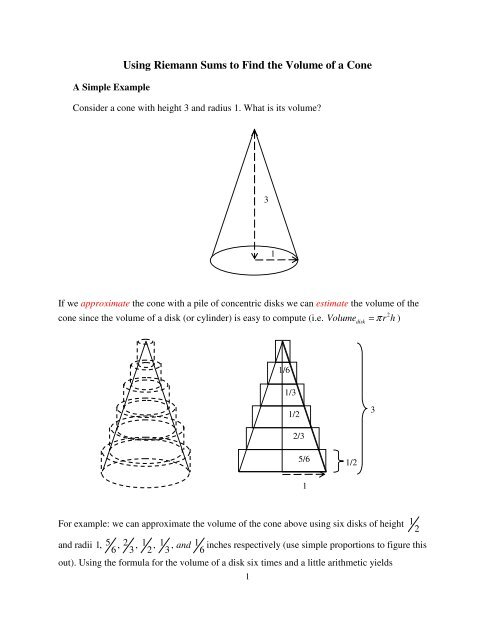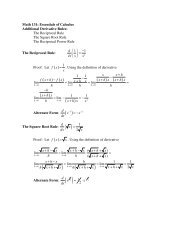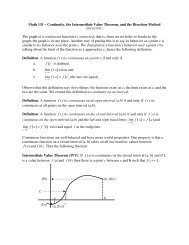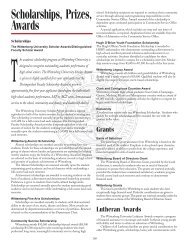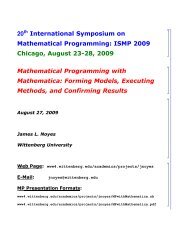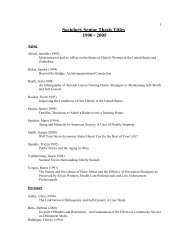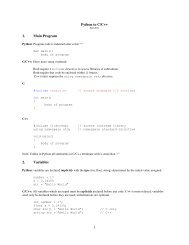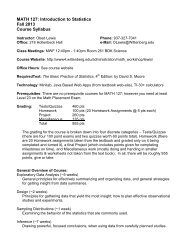Using Riemann Sums to Find the Volume of a Cone
Using Riemann Sums to Find the Volume of a Cone
Using Riemann Sums to Find the Volume of a Cone
You also want an ePaper? Increase the reach of your titles
YUMPU automatically turns print PDFs into web optimized ePapers that Google loves.
A Simple Example<br />
<strong>Using</strong> <strong>Riemann</strong> <strong>Sums</strong> <strong>to</strong> <strong>Find</strong> <strong>the</strong> <strong>Volume</strong> <strong>of</strong> a <strong>Cone</strong><br />
Consider a cone with height 3 and radius 1. What is its volume?<br />
3<br />
1<br />
If we approximate <strong>the</strong> cone with a pile <strong>of</strong> concentric disks we can estimate <strong>the</strong> volume <strong>of</strong> <strong>the</strong><br />
cone since <strong>the</strong> volume <strong>of</strong> a disk (or cylinder) is easy <strong>to</strong> compute (i.e.<br />
<strong>Volume</strong>disk<br />
2<br />
= π r h )<br />
1/6<br />
1/3<br />
1/2<br />
3<br />
2/3<br />
5/6<br />
1/2<br />
1<br />
For example: we can approximate <strong>the</strong> volume <strong>of</strong> <strong>the</strong> cone above using six disks <strong>of</strong> height 1 2<br />
and radii 1, 5 , 2 , 1 , 1 , and 1 inches respectively (use simple proportions <strong>to</strong> figure this<br />
6 3 2 3 6<br />
out). <strong>Using</strong> <strong>the</strong> formula for <strong>the</strong> volume <strong>of</strong> a disk six times and a little arithmetic yields<br />
1
91<br />
π ≈ 3.970624048 for <strong>the</strong> sum <strong>of</strong> <strong>the</strong> volumes <strong>of</strong> <strong>the</strong> six disks which approximates <strong>the</strong> volumes<br />
72<br />
<strong>of</strong> <strong>the</strong> cone.<br />
Exercise:<br />
Verify <strong>the</strong> above calculation. Is this estimate an upper bound or a lower bound for <strong>the</strong><br />
actual volume <strong>of</strong> <strong>the</strong> cone?<br />
<strong>Find</strong> a lower bound estimate for <strong>the</strong> volume <strong>of</strong> <strong>the</strong> cone. Hint: use inscribed disks (one <strong>of</strong><br />
which has a zero radius).<br />
<strong>Using</strong> a <strong>Riemann</strong> Sum <strong>to</strong> Approximate <strong>the</strong> <strong>Volume</strong><br />
Without <strong>to</strong>o much difficulty we can generalize <strong>the</strong> above <strong>to</strong> estimate <strong>the</strong> volume <strong>of</strong> any cone<br />
with arbitrary height h and radius r. Take <strong>the</strong> x-y plane. Tilt <strong>the</strong> cone on its side, aligning <strong>the</strong><br />
main axis <strong>of</strong> <strong>the</strong> cone <strong>the</strong> with positive x-axis, placing <strong>the</strong> apex at <strong>the</strong> origin (0,0) and positioning<br />
<strong>the</strong> center <strong>of</strong> <strong>the</strong> base at (0, h). The projection <strong>of</strong> <strong>the</strong> cone in<strong>to</strong> <strong>the</strong> x-y plane appears as a triangle<br />
with <strong>the</strong> upper corner at coordinates (h, r). Notice that disks as projected on<strong>to</strong> <strong>the</strong> plane appear as<br />
rectangles.<br />
(h, r)<br />
(0,0)<br />
(h,0)<br />
With this set up we can easily obtain a general formula for <strong>the</strong> sum <strong>of</strong> <strong>the</strong> volumes <strong>of</strong> any<br />
number <strong>of</strong> disks which in turn approximates <strong>the</strong> volume <strong>of</strong> <strong>the</strong> cone.<br />
Begin by partitioning <strong>the</strong> x-interval [0, h], <strong>the</strong> length <strong>of</strong> cone’s axis, in<strong>to</strong> n equal sub-intervals.<br />
Each sub-interval will have length h x<br />
n = ∆ - so ∆ x is <strong>the</strong> width or thickness <strong>of</strong> each disk.<br />
2
The radius <strong>of</strong> each disk is obtained by using <strong>the</strong> equation <strong>of</strong> <strong>the</strong> line determined by <strong>the</strong> two points<br />
r<br />
(0,0) and (h,r) which is y = x (remembering that h and r are constants). The radius <strong>of</strong> <strong>the</strong> first<br />
h<br />
disk is r x<br />
h ∆ . The radius <strong>of</strong> <strong>the</strong> r<br />
2nd disk is 2 x<br />
h ∆ . And <strong>the</strong> radius <strong>of</strong> <strong>the</strong> nth or last disk is r n x<br />
h ⋅ ∆ .<br />
So <strong>the</strong> sum <strong>of</strong> <strong>the</strong> volumes <strong>of</strong> all n disks is<br />
This is a <strong>Riemann</strong> Sum!<br />
2 2 2 2<br />
r r r r <br />
π ∆x ∆ x + π 2⋅ ∆x ∆ x + π 3 ⋅ ∆x ∆ x + ... + π n⋅ ∆x ∆x<br />
h h h h<br />
<br />
Fac<strong>to</strong>ring out common terms like , r h<br />
π and ∆ x , recalling that ∆ x = , and doing some algebra<br />
h<br />
n<br />
simplifies <strong>the</strong> <strong>Riemann</strong> Sum <strong>to</strong><br />
2<br />
r <br />
π <br />
h<br />
<br />
2<br />
r h<br />
3 2 2 2 2<br />
( x) ( 1 2 3 ... n )<br />
2 3<br />
r h <br />
π <br />
h<br />
n<br />
<br />
∆ + + + + =<br />
2 2 2 2<br />
( 1 2 3 ... n )<br />
2 2 2 2<br />
( 1 2 3 ... n )<br />
π ⋅ ⋅ + + + +<br />
3<br />
n<br />
+ + + + =<br />
Now it can be shown that <strong>the</strong> open expression 1 2 + 2 2 + 3 2 + ... + n<br />
2 for <strong>the</strong> sum <strong>of</strong> <strong>the</strong> first n<br />
squares is equal <strong>to</strong> <strong>the</strong> closed form<br />
( 1) ( 2 1)<br />
n⋅ n + ⋅ n +<br />
6<br />
3<br />
. Thus<br />
( + 1)( 2 + 1) ( + 1)( 2 + 1)<br />
n n n n n<br />
2<br />
r h<br />
2<br />
⋅ = π r h<br />
3 2<br />
π<br />
n<br />
6 6n<br />
Reality Check: If r = 1, h = 3 and n = 6 (<strong>the</strong> values used for <strong>the</strong> cone at <strong>the</strong> beginning <strong>of</strong> this<br />
paper), verify that you get <strong>the</strong> same answer - 91<br />
72 π .<br />
Since <strong>the</strong> above calculations used disks that covered <strong>the</strong> cone (circumscribed disks) <strong>the</strong> <strong>Riemann</strong><br />
Sum approximation <strong>of</strong> <strong>the</strong> volume obtained is an upper bound meaning <strong>the</strong> real volume <strong>of</strong> <strong>the</strong><br />
cone is actually smaller. We can used disks that fit inside <strong>the</strong> cone (<strong>the</strong> inscribed case) where <strong>the</strong><br />
radius is determined by <strong>the</strong> left hand sides <strong>of</strong> <strong>the</strong> inscribed rectangles (<strong>the</strong> dotted rectangles).It’s<br />
not difficult <strong>to</strong> obtain <strong>the</strong> <strong>Riemann</strong> Sum given below which is a lower bound estimate for <strong>the</strong><br />
volume <strong>of</strong> a cone (note that <strong>the</strong> left most inscribed disk has radius 0).
2<br />
r <br />
π <br />
h<br />
<br />
2<br />
r h<br />
( )<br />
2 2 2 2<br />
( x) 0 1 2 3 ... ( n 1)<br />
2 3<br />
r h <br />
π <br />
h<br />
n<br />
<br />
3 2<br />
∆ + + + + + − =<br />
2 2 2 2<br />
2<br />
( 0 1 2 3 ... ( n 1)<br />
)<br />
+ + + + + − =<br />
2 2 2<br />
2<br />
( 1 2 3 ... ( n 1)<br />
)<br />
π ⋅ ⋅ + + + + − =<br />
3<br />
n<br />
( n −1) ⋅ n⋅( 2n −1) ( n −1) ⋅( 2n<br />
−1)<br />
2<br />
r h<br />
2<br />
π r h<br />
3 2<br />
π ⋅ ⋅ = ⋅ ⋅<br />
n 6 6n<br />
Hence putting <strong>the</strong> lower and upper bound <strong>Riemann</strong> <strong>Sums</strong> <strong>to</strong>ge<strong>the</strong>r we know<br />
The Limit <strong>of</strong> <strong>the</strong> <strong>Riemann</strong> Sum.<br />
( n −1) ⋅( 2n − 1) ( n + 1) ⋅ ( 2n<br />
+ 1)<br />
π ⋅ r h ⋅ ≤ <strong>Volume</strong> ≤ π ⋅r h⋅<br />
6n<br />
6n<br />
2 2<br />
2 cone<br />
2<br />
What happens as <strong>the</strong> number <strong>of</strong> rectangles (or disks) used <strong>to</strong> approximate <strong>the</strong> volume increases<br />
(without bound). Intuitively we observe that we get better and better approximations <strong>to</strong> both <strong>the</strong><br />
lower and upper bounds for <strong>the</strong> volume. But specifically what happens in <strong>the</strong> limit?<br />
Since<br />
and likewise<br />
limπ<br />
r h<br />
n→∞<br />
( n + 1)( 2n + 1) ( n + 1)( 2n<br />
+ 1)<br />
= π r h⋅ lim<br />
?<br />
6n<br />
6n<br />
2 2<br />
2<br />
n→∞<br />
2<br />
( )( )<br />
2<br />
3 1<br />
2 + +<br />
n + 1 2n + 1 2n + 3n + 1 2 1<br />
lim = lim = lim n n =<br />
n→∞ 2 2<br />
6n<br />
n→∞ 6n<br />
n→∞<br />
6 3<br />
lim<br />
n→∞<br />
( n − )( n − )<br />
1 2 1 1<br />
=<br />
2<br />
6n<br />
3<br />
Both limits are <strong>the</strong> same! It follows that since <strong>the</strong> limits <strong>of</strong> both <strong>the</strong> upper and lower bounds<br />
(which sandwich <strong>the</strong> volume <strong>of</strong> <strong>the</strong> cone) approach <strong>the</strong> same value, <strong>the</strong> true volume <strong>of</strong> <strong>the</strong> cone<br />
is<br />
<strong>Volume</strong>cone<br />
1<br />
= π<br />
3<br />
2<br />
r h<br />
Thus <strong>the</strong> formula for <strong>the</strong> volume <strong>of</strong> a cone!<br />
4


